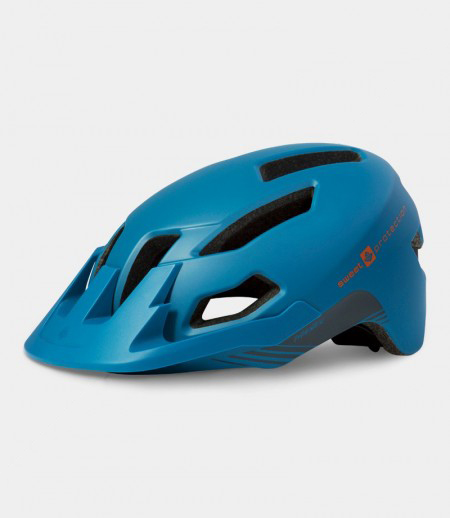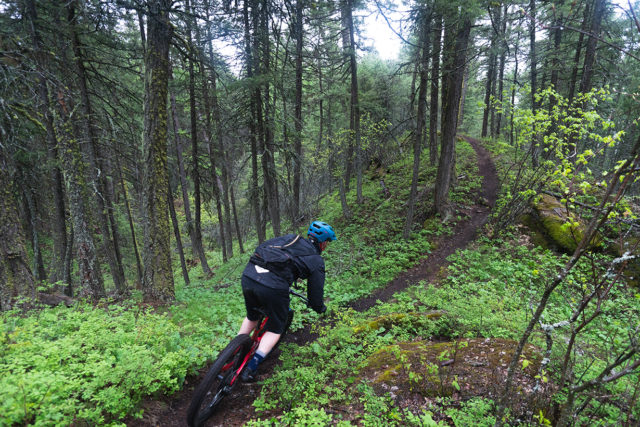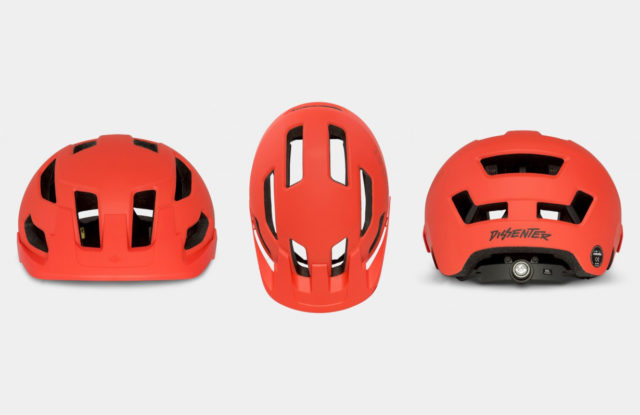
Sweet Protection Dissenter Helmet
Reviewer Head circumference: 57 cm
Size Tested: Medium / Large
Blister’s Measured Weight: 340 g
Stated Features:
- Mono-shell technology
- EPS-liner
- In-mold construction
- Occigrip turn-dial
- STACC — Superficial Temporal Artery Cooling Channel
- Reinforced in-molded strap anchors
- Shatter-resistant visor
Price: $129.95
Test Location: In, around, and on the Rocky Mountains
Days Tested: ~30 rides
Intro
Sweet Protection calls the Dissenter a “bang for the buck helmet,” which, within the Sweet Protection lineup, is an entirely accurate statement. At $130, the Dissenter comes in about $70 cheaper than their Bushwhacker II helmet, and about $170 less than their top-of-the-line Bushwhacker II Carbon MIPS.
So what do you give up by going with the more-budget-friendly Dissenter? And what does the Dissenter offer compared to some of the other reasonably-priced helmets that are at (or below) its price point?
Fit
I say this in every helmet review, but helmet fit is hugely important. It doesn’t matter how much (or how little) you spend — if the helmet doesn’t fit you well, it’s not going to protect your head well. Finding a helmet that fits your head matters way more than what your friends think is good, which helmet matches your gloves, or whether this review says the Dissenter is awesome or not.

So with that caveat in mind, I’d say the Dissenter fits slightly on the wide and round end of the helmet spectrum. It’s not nearly as wide and round as the helmets I’ve used from Bell, but it’s a bit rounder than most helmets from Giro. I’d say the Dissenter feels roughly similar in fit to most helmets from Smith (e.g., the Rover).
It’s also worth noting that the Dissenter, like other helmets from Sweet Protection that I’ve used, sits pretty low on my head. It feels like the Dissenter surrounds my head better than most comparable options, and thus offers more coverage / protection. But this also means that I notice the Dissenter more at the upper edge of my vision, and I found that the edges of the helmet behind my ears interfered with some (but not all) sunglasses.

The Dissenter’s “Occigrip” dial head retention system is roughly similar in design to many other helmets on the market, but it works incredibly well. More so than most helmets on the market, the Occigrip system really feels like it has a deathgrip on my head. But in a good way. A comfortable deathgrip.
Construction / Safety
The Dissenter comes in two versions — one with MIPS, and one without. I tested the version without MIPS, but going with the MIPS version bumps up the price of the Dissenter by $40. You can read a more in-depth explanation of the case for MIPS in our MIPS helmet roundup, but here’s the quick version: MIPS adds a slip plane to the helmet that helps protect against oblique impacts and brain injuries related to rotational forces. Most of the studies on the subject have come from within the industry, and thus tend to be criticised as being self-serving. But regardless, those studies show a tangible benefit from MIPS in particular situations. My take: If given the choice, I’d rather have a helmet that has some sort of feature that protects against rotational impacts. MIPS does make helmets less breathable, but I’m ok with that tradeoff.
Beyond the MIPS aspect of the Dissenter, there are a couple other noteworthy aspects of its construction. First, the Dissenter’s expanded polystyrene (EPS) construction is a bit more carved out than most helmets I’ve used, especially those helmets at the Dissenter’s price point. Sweet Protection says this construction optimizes protection, and while I can’t speak to that, I can say that the more open construction does help increase airflow through the Dissenter.

Sweet Protection also says they reinforced the areas where the Dissenter’s straps anchor into the helmet. Again, I can’t verify how much stronger the anchor points are, but I do know that the straps utilize a fairly clean system that sits nice and flat against my face.
On-Trail Performance
As I mentioned above, maybe the most noteworthy feature of the Dissenter is how sculpted the EPS is on the inside of the helmet. This is pretty similar to Sweet Protection’s higher-end Bushwhacker II helmets, but it’s something that you don’t usually see on less expensive helmets like the Dissenter. It makes a noticeable difference in airflow at pretty much any speed, and it’s the feature that I’d say sets the Dissenter apart from other comparably priced helmets.

To frame that discussion another way, there are other reasonably priced helmets that have a bunch of vents and breathe pretty well, though many of them are a bit more XC- or road-oriented than the Dissenter. The Dissenter also breathes pretty well, but it does so via aggressive sculpting of the inside of the helmet, rather than including a ton of vents and / or skimping on coverage. And while the Dissenter may not be quite as airy as some road helmets, it offers a lot more coverage and protection than most road helmets, particularly around the back of the head. So I’d say the Dissenter actually does a pretty good job of keeping things cool when compared to other similarly priced, Trail-oriented helmets that are geared more towards offering solid protection.
We reviewed the Smith Rover last year, which, at $120, comes in at a similar price point as the Dissenter, and is roughly comparable to the Dissenter in terms of intended use (i.e. all-around Trail riding). Both helmets run decently cool, but the Rover accomplishes that by having more vents, while the Dissenter gets there by having a more sculpted interior that lets air flow through. The end result is somewhat similar in terms of cooling, but I’d give the nod to the Dissenter in terms of protection since it has fewer holes in it, and comes down a smidge lower on the head.
The downside of the Dissenter’s ridgey interior is that, depending on your head shape, it can create some pressure points. Sweet Protection has improved their padding over the years to help address this issue, but when putting on the Dissenter for the first time, I definitely noticed a few specific contact spots. But the Dissenter’s pads do a pretty good job of alleviating that, and ultimately, none of the pressure points were all that noticeable once I started riding. But everyone’s head is a little different, so you’ll want to make sure the Dissenter works well with your head.

The Dissenter does a pretty good job of sweat management — its pads are fairly small, but they soak up a decent amount of sweat, and more importantly, they don’t channel it into my eyes.
I spent a day in the Dissenter riding Windrock Bike Park, which is a place where a full-face helmet really makes the most sense. But the Dissenter was what I had with me, so it’s what I used. As will happen when I start following fast guys down trails that I don’t know well, I ended up picking a dumb line, ate shit, and smacked my head pretty good. The Dissenter dented a bit and is probably no longer safe to use, but it did its job well, and I don’t appear to be any stupider than I was prior to the crash. So at least with my very limited sample size of one, I’d say that the Dissenter passed the crash test.
Bottom Line
It’s easy to throw a lot of money at a helmet. There are plenty of options on the market that cost a small fortune, and have all kinds of fancy materials, technology, and gadgets attached to them. But at the more reasonable end of the pricing spectrum, helmets tend to be a bit more homogeneous — they’re made with a basic EPS foam mold, and they sometimes get a MIPS system.
The Sweet Protection Dissenter isn’t the absolute cheapest option on the market, but its price is still within the realm of reason. And for that price, you get a helmet that’s noticeably different from some of the other inexpensive options thanks to the Dissenter’s interior, which is shaped to promote airflow and actually works quite well.
So if you’re looking for a Trail-oriented helmet that offers pretty good protection, has good airflow, and hits a price point that doesn’t require hooking up a Hoover to the ATM machine, check out the Dissenter.
